Asphodelaceae
Aloe castanea Schönland
Family:
Common names: cat's tail aloe (Eng.), katstertaalwyn (Afr.), borolo, suwopa, sekgopha (Northern Sotho)
Plant Attributes:
Plant Type:
SA Distribution:
Soil type:
Flowering season:
PH:
Flower colour:
Aspect:
Gardening skill:
Special Features:
Horticultural zones

Aloe rupestris Baker
Family:
Common names: bottlebrush aloe, rock aloe (Eng); borselaalwyn, kraalaalwyn (Afr.); inhlaba (Siswati); uphondonde (isiXhosa); inkalane, uphondonde, umhlabanhazi (isiZulu),
Plant Attributes:
Plant Type:
SA Distribution:
Soil type:
Flowering season:
PH:
Flower colour:
Aspect:
Gardening skill:
Special Features:
Horticultural zones

Aloe spicata L.f.
Family:
Common names: Lebombo aloe, bottle-brush aloe, Gazaland aloe (Eng.); lebombo-aalwyn (Afr.); inhlaba (isiZulu), tshikhopa (Tshivenda)
Plant Attributes:
Plant Type:
SA Distribution:
Soil type:
Flowering season:
PH:
Flower colour:
Aspect:
Gardening skill:
Special Features:
Horticultural zones

Aloe kniphofioides Baker
Family:
Common names: grass aloe, red poker grass aloe (Eng.); grasaalwyn (Afr.)
Plant Attributes:
Plant Type:
SA Distribution:
Soil type:
Flowering season:
PH:
Flower colour:
Aspect:
Gardening skill:
Special Features:
Horticultural zones

Aloe pretoriensis Pole Evans
Family:
Common names: Pretoria aloe (Eng.); Pretoria aalwyn (Afr.)
Plant Attributes:
Plant Type:
SA Distribution:
Soil type:
Flowering season:
PH:
Flower colour:
Aspect:
Gardening skill:
Special Features:
Horticultural zones

Tulista Raf.
Family:
Common names: miniature aloe, pearl plant (Eng.); vratjiesaalwyn, kleinaalwyn, seepaalwyn (Afr.)
Species

Tulista kingiana (Poelln.) Gideon F.Sm. & Molteno (= Haworthia kingiana Poelln.)
Plants form a stemless rosette, with erect to spreading, yellowish green leaves. Rosettes can be up to 180 mm tall, but are usually smaller than this, and occasionally form few-headed clusters. The leaf surface is scabrid (rarely glabrous) with white to concolorous, raised, non-confluent tubercles.
This species has a narrow distribution, restricted to a few scattered populations in the vicinity of Mossel Bay, Hartenbos, Great Brak, and near Herbertsdale in the Western Cape Province, South Africa. Plants are normally found in sandy soils, and either grow exposed in grassy terrain or sheltered beneath larger shrubs on sloped rocky areas.

Tulista marginata (Lam.) G.D.Rowley [= Haworthia marginata (Lam.) Stearn]
Plants form a stemless rosette, with erect to spreading, pale brownish green leaves. Rosettes are up to 200 mm tall, and occasionally form small clusters. The leaf surface is smooth and usually without any tubercles.
This variable species is restricted to the Western Cape, South Africa, from near Ashton and Bredasdorp in the west, to Riversdale in the east. These large plants usually grow exposed on flat to sloped grassy terrain with scattered shrubs.

Tulista minor (Aiton) Gideon F.Sm. & Molteno [= Haworthia minor (Aiton) Duval; H. minima (Aiton) Haw.]
Plants form a stemless rosette, with erect to spreading, light to darker green leaves (only occasionally bluish green). Rosettes are up to 150 mm tall, and occasionally form small clusters. The leaf surface is scabrid with white, raised, flattened, non-confluent tubercles. This species is morphologically variable, with many interesting and distinct geographical forms.
This is the most widespread species in the genus. It is mainly a coastal species, and is known from near Mossel Bay in the east, to Bredasdorp in the west, and to the north of the Langeberg Mountains, Western Cape Province, South Africa. The habitat varies considerably, but it is generally found in grassy vegetation.

Tulista pumila (L.) G.D.Rowley [= Haworthia pumila (L.) Duval; H. margaritifera (L.) Haw.; Haworthia maxima (Haw.) Duval]
Plants form a stemless rosette, with erect to spreading, brownish to olive-green leaves. Rosettes are up to 250 mm tall, and occasionally form small clusters. The leaf surfaces are variably scabrid with white, raised, generally rounded, non-confluent tubercles.
This species has a wide distribution range in the Western Cape, South Africa, and is the only species in the genus that may be locally abundant in some areas. Its main distribution area lies from near Worcester, eastwards to near Laingsburg in the north, and Swellendam in the south. The typical form is found in the Worcester-Robertson Karoo area, whereas some of the outlying populations are morphologically variable.
Plant Attributes:
Plant Type:
SA Distribution:
Soil type:
Flowering season:
PH:
Flower colour:
Aspect:
Gardening skill:
Special Features:
Horticultural zones

Astroloba rubriflora (L.Bolus) Gideon F.Sm. & J.C.Manning
Family:
Common names: red-flowered astroloba
Plant Attributes:
Plant Type:
SA Distribution:
Soil type:
Flowering season:
PH:
Flower colour:
Aspect:
Gardening skill:
Special Features:
Horticultural zones

Trachyandra falcata (L.f.) Kunth
Family:
Common names: Namaqua wild cabbage (Eng.); namakwakool, veldkool, bokkool (Afr.)
Plant Attributes:
Plant Type:
SA Distribution:
Soil type:
Flowering season:
PH:
Flower colour:
Aspect:
Gardening skill:
Special Features:
Horticultural zones

Haworthiopsis coarctata (Haw.) G.D.Rowley (= Haworthia coarctata Haw.)
Family:
Common names: crowded haworthiopsis
Plant Attributes:
Plant Type:
SA Distribution:
Soil type:
Flowering season:
PH:
Flower colour:
Aspect:
Gardening skill:
Special Features:
Horticultural zones

Haworthiopsis G.D.Rowley
Family:
Common names:
Species

Haworthiopsis attenuata (Haw.) G.D.Rowley [= Haworthia attenuata (Haw.) Haw.]
The zebra plant is an attractive rosette-forming plant, with erect to spreading leaves exhibiting an array of different leaf tubercle variation. Plants range from about 50 mm to 100 mm tall and form dense clusters. The white tubercles range from fine to conspicuous tubercles, scattered over the lower leaf surfaces, or forming confluent bands reminiscent of zebra bands, hence its common name.
This species is found widespread in the Eastern Cape, from near the Gamtoos River in the west to the Mbashe River in the east. This species has 2 described varieties, var. glabrata and var. radula.
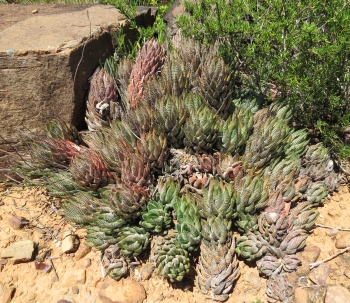
Haworthiopsis coarctata (Haw.) G.D.Rowley (= Haworthia coarctata Haw.)
This stemmed species of Haworthiopsis is easy to grow and makes excellent rock-garden subjects. Plants are stemmed, about 50–200 mm tall, growing longer as the stems become decumbent with age. Plants proliferate from the base and along the stem to form dense clumps. The lower leaf surfaces may be smooth or tuberculate and are clasping, covering most of the length of the stem.
This species is found in the Eastern Cape, from near Port Elizabeth in the west to the Fish River in the east. The generally smaller growing var. adelaidensis has a narrower distribution range.
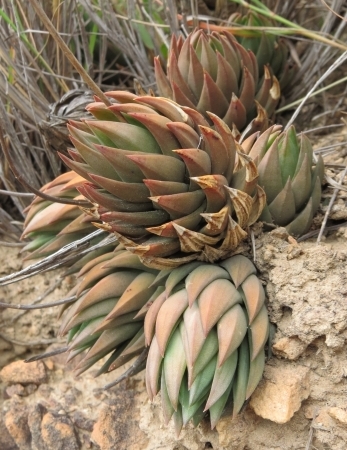
Haworthiopsis glauca (Baker) G.D.Rowley (= Haworthia glauca Baker)
This species is similar in appearance to H. coarctata and H. reinwardtii by sharing the same stemmed growth habit, but differ in having glaucous grey-coloured leaves. In most forms the plants are without distinct white tubercles, however, white tubercles are found on the leaf surfaces in plants of the var. herrei. In this species, plants also proliferate from the base and occasionally along the stem to form clumps, growing up to about 200 mm tall.
This species is found further inland than the above-mentioned and is known from relatively drier areas.
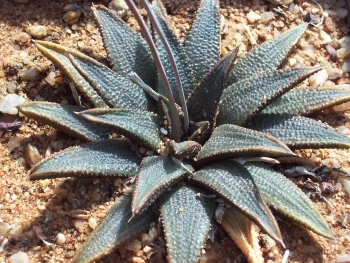
Haworthiopsis koelmaniorum (Oberm. & Hardy) Boatwr. & J.C.Manning (= Haworthia koelmaniorum Oberm. & Hardy)
This is the only species in the genus known to occur in the northern bushveld of Limpopo and extending its distribution into Mpumalanga, where the var. mcmurtyi occurs in grassland. This window-leaved species has star-like rosettes of spreading leaves that grows to about 100 mm in diameter. The var. mcmurtyi is very similar in appearance, but is generally much smaller in size than the typical variety.
Plants are slow-growing and best suited to cultivation in containers, planted in a well-drained medium. Plants rarely produce offsets and it is best propagated from seed or leaves.
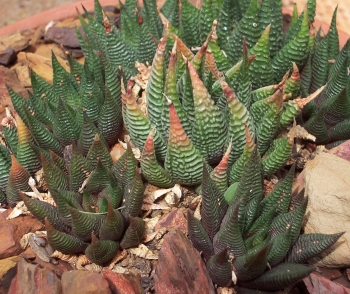
Haworthiopsis limifolia (Marloth) G.D.Rowley (= Haworthia limifolia Marloth)
This species is well suited to rockeries in summer rainfall areas. Plants form attractive rosettes of spiralling leaves, varying from being smooth to tuberculate, often with the tubercles forming confluent bands or ridges.
The only species in the genus known to occur in KwaZulu-Natal; it is also found in Mpumalanga and extending its distribution into Swaziland and possibly Mozambique. This species has become rare in its natural habitat because of over-collection for traditional purposes. Several varieties are recognised: var. arcana, var. gigantea, var. glaucophylla and var. ubomboensis.
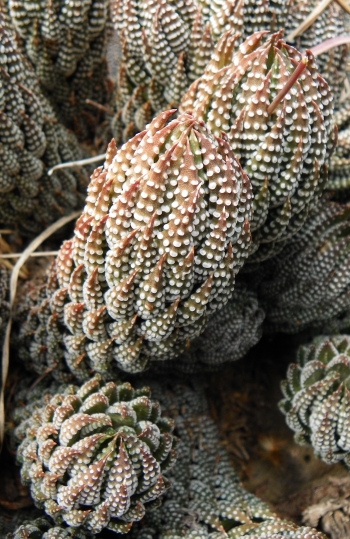
Haworthiopsis reinwardtii (Salm-Dyck) G.D.Rowley (= Haworthia reinwardtii (Salm-Dyck) Haw.)
Plants are stemmed, about 50–150 mm tall, growing longer as the stems become decumbent with age. Plants proliferate from the base and occasionally along the stem to form clumps. This species is similar in appearance to H. coarctata, but has narrower and denser arranged leaves and more conspicuous tuberculation. Lower leaf surfaces are generally densely tuberculate and are clasping, covering most of the length of the stem.
This species is found in the Eastern Cape, from west of the Fish River in the west to near East London in the east. The var. brevicula is generally smaller growing and has denser tooth-like tubercles.
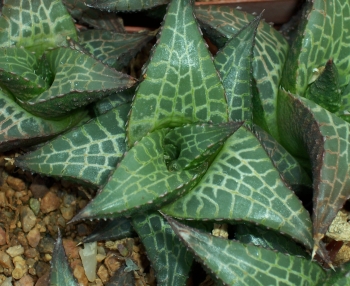
Haworthiopsis tessellata (Haw.) G.D.Rowley (= Haworthia tessellata Haw.)
The species is best suited to containers; it has a highly stoloniferous habit and produce many plantlets to eventually form a dense mat of compact rosettes. The starry rosettes (20–80 mm in diameter) have spreading to recurved leaves, with lines and reticulations, that are windowed on the upper surface.
This species is widespread and is known from the drier interior of South Africa where it is found in the Western Cape, Eastern Cape, Northern Cape, Free State and North-West Provinces. The distribution of this species also extends into Namibia. The var. crousii is similar in appearance to the typical variety, although much more robust and less proliferous.
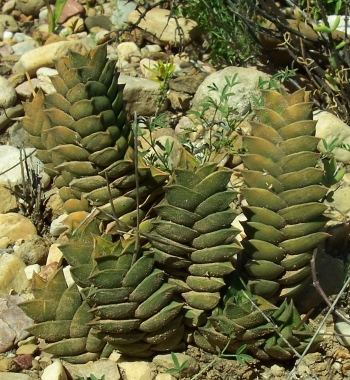
Haworthiopsis viscosa (L.) Gildenh. & Klopper (= Haworthia viscosa (L.) Haw.)
This species has a very interesting distinctly 3-ranked leaf arrangement along the length of the stem. It is a slow growing, hardy species that is best suited to cultivation in containers.
It is found mainly in the Western Cape, but also extends into the Eastern Cape. It can be found at lower altitudes on rocky areas closer to the coast, to further inland at higher altitudes. It is a variable species, both in terms of size, as well as leaf form and colouration.
Plant Attributes:
Plant Type:
SA Distribution:
Soil type:
Flowering season:
PH:
Flower colour:
Aspect:
Gardening skill:
Special Features:
Horticultural zones






Rate this article
Article well written and informative
Rate this plant
Is this an interesting plant?
Login to add your Comment
Back to topNot registered yet? Click here to register.